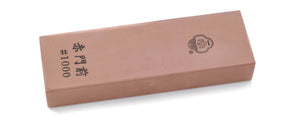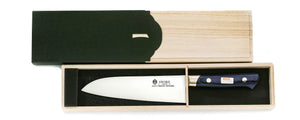
Montanren Series
Some of the highest quality forged knives available, with supreme hardness and toughness levels. With higher hardness and wear resistance than Blue Steel #2, the edge retention is significantly boosted, making this knife perfect for those who cook for long periods and need a knife to stay sharp for the entire session. A wavy pattern called a "Montanren" is visible on the back of the knife; our Montanren Series gets its name from this very pattern. This wave is the boundary between the softer iron and harder carbon steel and is reminiscent of patterns found on traditional Japanese swords.
| Product number | Actual Blade Length (mm) | Full Length (mm) | Total Weight (g) |
|---|---|---|---|
| 1ue7-195 | 185 | 335 | 210 |
| 1ue7-210 | 200 | 350 | 245 |
| 1ue7-225 | 210 | 370 | 280 |
| 1ue7-240 | 230 | 390 | 320 |
| Blade | Material Name | Handle |
|---|---|---|

Single Edged |
Blue Steel #1 | Yew octagonal handle |

Usuba (Edo Type)
Usuba knives are traditionally used for cutting and peeling vegetables in Japanese cuisine. Edo-type (rectangle-shape) usuba are more commonplace in Kanto and Eastern Japan. The rounded top edge prevents cutting board-based damage and scoops ingredients with ease. Most professionals use a 210-240mm usuba knife for quick processing. This size is also suitable for the home, but 180mm is better for smaller vegetables.

Blue Steel #1
A harder version of Blue Steel #2. While chip-resistant with amazing edge retention, you need to know how to sharpen properly to use it.
Carbon Steel
Blue Steel #1 is a higher carbon version of Blue Steel #2, and thus a harder steel. Both Blue Steels are made by adding trace amounts of tungsten and alloy carbides (both for hardness), and chromium (for toughness and rust resistance) to White Steel, creating a very tightly bonded alloy steel. The higher carbon levels in Blue Steel #1 increase hardness levels even further, leading to better sharpness and edge retention. We recommend Blue Steel #1 to those who want a premium cutting experience, but also need a knife that stays sharp for a long time. This is truly a steel for professionals.
*NOTE: Carbon Steel is susceptible to rust if it is not properly cared for. Please clean and dry the blade regularly during use and after use.

Yew octagonal handle
Japanese yew wood has been used for thousands of years as a material for shaku (a ritual baton used by the emperor and high-class officials in ancient Japan, and Shinto priests now) due to its beautiful grain patterns and high durability. Also known for its high natural oil content and long lifespan, it's a popular material for high-end furniture and wood carvings. As the years pass, the wood's color darkens, giving it an attractive appearance unique to each piece.

Forge Welded
Forge Welded knives undergo a forging process where steel is heated to high temperatures and then shaped with a hammer. This carefully done process changes the internal structure of the steel, producing a blade with superior hardness levels. Highly skilled craftspeople forge, quench, and create the knife's cutting edge by hand, resulting in a sharp blade with long edge retention.

Optional Engraving
Optional Engraving Service
Sakai Ichimonji provides complimentary engraving using either Japanese Kanji or English Alphabet. Please specify your preference. For details, please visit here
A knife store that has supported the history of knives and food culture in Japan.
It has been 600 years since the birth of swordmaking in the Sakai region of Japan. Sakai Ichimonji Mitsuhide's and it's craftsmen continue to build on that legacy by producing the finest blades in Japan.
This is where the culture of completing a dish of sashimi by "just cutting" and the culture of expressing sharpness as "taste" was born.
For 70 years, we have been connecting the spirit of Sakai's craftsmen with the passion of chefs in Osaka's kitchen equipment shopping district, known as the kitchen of Japan.
We are very happy that our knives can be used by people all over the world.
Precautions
After use, wash off any dirt and wipe thoroughly with a dry cloth to remove any moisture. This product is not for use with frozen foods.This product is handmade, so each piece will be different. Please use the weight and length listed as a guide. Each material is natural and may vary in color. It is not the same as the picture.We take great care with our inventory, but in the unlikely event that we are out of stock, we will contact you by email to let you know.













































